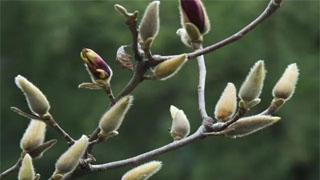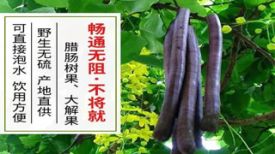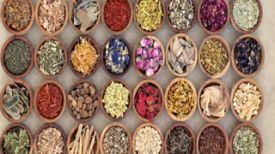
Nickname: Wooden Pen Flower
Harvesting and processing: From January to March, cut off unopened flower buds at the stem, expose them to sunlight during the day, and pile them up in piles at night to make them dry and wet evenly inside and outside. When it is 50% dry, stack it for 1-2 days and then dry it completely. If it rains, it can be dried.
Medicinal parts: flower buds
Origin: Southern Shaanxi, Gansu, Western Henan, Western Hubei, Sichuan, etc
Family: Magnoliaceae
Original plant: Wangchun Flower (Wangchun Magnolia)
Plant condition: deciduous trees
Single leaf mutualism; The petiole is 1-2cm long and has leaf support marks at the base; The leaves are oblong lanceolate or ovate lanceolate, 10-18cm long and 3.5-6.5cm wide, with a pointed tip and a rounded or wedge-shaped base. They are entire and have a dark green surface, smooth texture, and a light green back with sparse hairs along the veins.
Flowers bloom first, with solitary branches at the top and sparse axillary branches. They are bell shaped, with a diameter of 6-8cm, white in color, and have a purple red outer base. They are fragrant; Outer corolla 3, sepal shaped sublinear, about a quarter of the petal length; 3 middle and inner whorls, spoon shaped, measuring 4-8cm in length and approximately 2.5cm in width; The stamens are mostly arranged in a spiral pattern at the lower part of the elongated receptacle; The pistil is mostly arranged in the upper part of the receptacle.
Aggregate fruit cylindrical, slightly twisted, 8-13cm long; Wood. The seed is inverted. The flowering period is from February to March, and the fruiting period is in September.
Characteristics of Xinyi Wangchunhua medicinal herb: The flower bud is long and oval shaped, resembling a hairy pen tip, measuring 1.2-2.5cm in length and 0.8-1.5cm in diameter. The base often has a short woody stem, about 5mm in length, with white dotted pores on the stem. There are 2-3 layers of bracts, with 2 pieces per layer. There are small scales between the two layers of bracts, and the outer surface of the bracts is densely covered with gray white or gray green long hairs. The inner surface is brown and hairless. The flower petals are 9, 3 rounds, brown in color. The outer petals are strip-shaped, about 1/4 of the length of the inner petals, and are calyx shaped; The stamens are numerous and spiral shaped, growing in the lower part of the receptacle. The filaments are flat and the anthers are linear; The pistil is mostly spiral shaped and grows on the upper part of the receptacle. Lightweight and brittle in texture. The aroma is fragrant, the taste is spicy, cool, and slightly bitter.
High quality products are best if the flower buds are not yet bloomed, the body is dry, the color is green, and there are no branches or stems.
Xinyi medicinal properties:
The top-grade Xinyi flavor of this sutra is spicy and warm. The body of the main five zang is cold and hot, the wind and brain are painful, and the face is black and dry. After long-term consumption, the qi is lowered, the body is light and the vision is improved, and aging is prolonged. Xin (Yayin), Hou Tao, Fang Mu
Spicy in taste, slightly warm, starting with Taiyin Lung and Foot Yangming Stomach Meridian. Relieve the lungs and reduce reflux, promote qi circulation and break blockages.
Xinyi can relieve diarrhea in the lungs and stomach, relieve headaches, dizziness, toothache, nasal congestion, reduce runny nose (black dryness), dispel cold and relieve itching. Apply makeup to the skin and blow on the nose to treat sores.
Also known as wooden brush flower.
【 Origin 】 It can be found everywhere, planted in gardens, with tall trees and medicinal buds.
[Taste] Spicy, warm in nature, non-toxic.
【 Indications 】 Xinyi requires medicine for the treatment of ascending yang, and is responsible for treating various mental illnesses such as nasal congestion, promoting gastric qi, and expelling lung qi.
【 Additional Record 】 Warm the middle and relieve muscle, benefit the nine orifices, clear the nose, relieve nasal congestion, treat facial swelling, toothache, and dizziness, as if on a vehicle or boat. It can also promote hair growth and eliminate white worms.
[Da Ming] Passes through the meridians, treats headaches, suppresses coldness and quiets the body, itches, and produces a glossy appearance on the face. Spiritual fetus: Soothing the liver and dispersing wind.
[Dosage] Ordinary one or two yuan.
【 Taboos 】 Avoid those with qi deficiency, occasional wind cold and nasal congestion, blood deficiency and fire burning caused by headache, stomach fire caused by toothache, and those who dislike red stone fat and fear Acorus calamus, Coptis chinensis, and Puhuang gypsum.
The medicinal properties of this herb are elevated, leading to various diseases on the head and face. It can be used to induce various herbs to ascend to the head and face, and the meridian says that brain leakage is called nasal discharge. Wang Bing said that if the bile is not clear, it is cloudy nasal discharge, like a continuous spring, hence the name nasal abyss.
【 Rongchuan 】 Xinyi flowers are located in the treetops, and their nature is extremely high. They have a pungent and fragrant taste, so they can dispel the wind and cold between the brain and nose.
[Preparation] Pick out impurities and stems, and remove the ash to obtain. "
[Taste] Spicy, warm.
Return to the lung and stomach meridians.
【 Functions and Indications 】 Relieve wind and cold, and promote nasal circulation. Used for wind cold headache, nasal congestion, nasal sinusitis, and cloudy nasal discharge.
【 Usage and Dosage 】 3-9g; Apply in moderation for external use.
【 Storage 】 Store in a cool and dry place.


